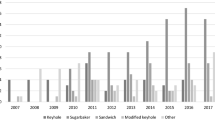Abstract
This study aimed to analyze the outcomes of the sandwich technique for repair of parastomal hernia and provide laparoscopic intracorporeal visualization of a case 1 year following repair of parastomal hernia using the sandwich technique. Laparoscopic repair for parastomal hernia was performed using the sandwich technique. Patients characteristics and surgical outcomes were analyzed. The sandwich technique was performed in 13 patients. The mean body mass index was 29.3 kg/m2. No complications or adverse events were noted during the perioperative period. Mean hospital stay after surgery was 4 days. There were no signs of recurrence during follow-up period. In addition, we present a case of laparoscopic view after performing sandwich technique in a patient with parastomal hernia. The sandwich technique is useful and feasible for the treatment of parastomal hernia. It is necessary to understand of the characteristics of the mesh to treat parastomal hernia.



Similar content being viewed by others
References
Pearl RK (1989) Parastomal hernias. World J Surg 13(5):569–572
Cingi A, Cakir T, Sever A, Aktan AO (2006) Enterostomy site hernias: a clinical and computerized tomographic evaluation. Dis Colon Rectum 49(10):1559–1563. https://doi.org/10.1007/s10350-006-0681-4
Moreno-Matias J, Serra-Aracil X, Darnell-Martin A, Bombardo-Junca J, Mora-Lopez L, Alcantara-Moral M, Rebasa P, Ayguavives-Garnica I, Navarro-Soto S (2009) The prevalence of parastomal hernia after formation of an end colostomy. A new clinico-radiological classification. Colorectal disease : the official journal of the Association of Coloproctology of Great Britain and Ireland 11(2):173–177. https://doi.org/10.1111/j.1463-1318.2008.01564.x
De Raet J, Delvaux G, Haentjens P, Van Nieuwenhove Y (2008) Waist circumference is an independent risk factor for the development of parastomal hernia after permanent colostomy. Dis Colon Rectum 51(12):1806–1809. https://doi.org/10.1007/s10350-008-9366-5
Rosin JD, Bonardi RA (1977) Paracolostomy hernia repair with Marlex mesh: a new technique. Dis Colon Rectum 20(4):299–302
Sugarbaker PH (1980) Prosthetic mesh repair of large hernias at the site of colonic stomas. Surg Gynecol Obstet 150(4):576–578
Berger D, Bientzle M (2007) Laparoscopic repair of parastomal hernias: a single surgeon's experience in 66 patients. Dis Colon Rectum 50(10):1668–1673. https://doi.org/10.1007/s10350-007-9028-z
Berger D, Bientzle M (2009) Polyvinylidene fluoride: a suitable mesh material for laparoscopic incisional and parastomal hernia repair! A prospective, observational study with 344 patients. Hernia : the journal of hernias and abdominal wall surgery 13(2):167–172. https://doi.org/10.1007/s10029-008-0435-4
Wada T, Kawada K, Hasegawa S, Sakai Y (2016) Laparoscopic repair for recurrent parastomal hernia of an end stoma using the sandwich technique while preserving an ileal conduit: a case report. Int J Surg Case Rep 25:75–78. https://doi.org/10.1016/j.ijscr.2016.06.007
O'Neill CH, Borrazzo EC, Hyman NH (2015) Parastomal hernia repair. Journal of gastrointestinal surgery : official journal of the Society for Surgery of the Alimentary Tract 19(4):766–769. https://doi.org/10.1007/s11605-014-2717-8
Arumugam PJ, Bevan L, Macdonald L, Watkins AJ, Morgan AR, Beynon J, Carr ND (2003) A prospective audit of stomas--analysis of risk factors and complications and their management. Colorectal disease : the official journal of the Association of Coloproctology of Great Britain and Ireland 5(1):49–52
Carne PW, Robertson GM, Frizelle FA (2003) Parastomal hernia. Br J Surg 90(7):784–793. https://doi.org/10.1002/bjs.4220
Jansen PL, Mertens Pr P, Klinge U, Schumpelick V (2004) The biology of hernia formation. Surgery 136(1):1–4. https://doi.org/10.1016/j.surg.2004.01.004
Ripoche J, Basurko C, Fabbro-Perray P, Prudhomme M (2011) Parastomal hernia. A study of the French federation of ostomy patients. J Visc Surg 148(6):e435–e441. https://doi.org/10.1016/j.jviscsurg.2011.10.006
Halabi WJ, Jafari MD, Carmichael JC, Nguyen VQ, Mills S, Phelan M, Stamos MJ, Pigazzi A (2013) Laparoscopic versus open repair of parastomal hernias: an ACS-NSQIP analysis of short-term outcomes. Surg Endosc 27(11):4067–4072. https://doi.org/10.1007/s00464-013-3062-9
Asif A, Ruiz M, Yetasook A, Denham W, Linn J, Carbray J, Ujiki MB (2012) Laparoscopic modified Sugarbaker technique results in superior recurrence rate. Surg Endosc 26(12):3430–3434. https://doi.org/10.1007/s00464-012-2358-5
Hansson BM, Bleichrodt RP, de Hingh IH (2009) Laparoscopic parastomal hernia repair using a keyhole technique results in a high recurrence rate. Surg Endosc 23(7):1456–1459. https://doi.org/10.1007/s00464-008-0253-x
Mizrahi H, Bhattacharya P, Parker MC (2012) Laparoscopic slit mesh repair of parastomal hernia using a designated mesh: long-term results. Surg Endosc 26(1):267–270. https://doi.org/10.1007/s00464-011-1866-z
Junge K, Klinge U, Rosch R, Lynen P, Binnebosel M, Conze J, Mertens PR, Schwab R, Schumpelick V (2007) Improved collagen type I/III ratio at the interface of gentamicin-supplemented polyvinylidenfluoride mesh materials. Langenbeck's Arch Surg 392(4):465–471. https://doi.org/10.1007/s00423-006-0138-1
Funding
This study was not funded.
Author information
Authors and Affiliations
Contributions
HH contributed to study conception and design, data analysis and interpretation, and preparation of the manuscript. YK, MK, HK, and SK participated in data collection and analysis. All authors read and approved the final manuscript.
Corresponding author
Ethics declarations
Conflict of Interest
The authors declare that they have no conflict of interest.
Statement of Human Rights
All procedures performed in studies involving human participants were in accordance with the ethical standards of the institutional and/or national research committee and with the 1964 Helsinki Declaration and its later amendments or comparable ethical standards.
Statement on the Welfare of Animals
This article does not contain any studies with animals performed by any of the authors.
Ethical Approval
The study was approved by the Ethics Committee of Kobe City Medical Center General Hospital. (No. zn191101).
Informed Consent
Informed consent was obtained from all individual participants included in the study.
Additional information
Publisher’s Note
Springer Nature remains neutral with regard to jurisdictional claims in published maps and institutional affiliations.
Electronic supplementary material
ESM 1
(AVI 395181 kb)
Rights and permissions
About this article
Cite this article
Hashida, H., Kumata, Y., Kondo, M. et al. Analysis of the Outcome of Laparoscopic Repair for Parastomal Hernia Using the Sandwich Technique. Indian J Surg 83, 542–546 (2021). https://doi.org/10.1007/s12262-020-02316-6
Received:
Accepted:
Published:
Issue Date:
DOI: https://doi.org/10.1007/s12262-020-02316-6




